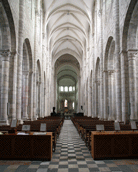 |
LOIRET |
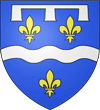 |
| Clery-Saint-André | Ferrières-en-Gâtinais | Montargis | Saint-Benôit-sur-Loire |
 |
Cléry-Saint-André - Collegiate Church of Our Lady |
 |
| Church open during normal hours; there is a guided tour of the crypt which contains the coffins of the King and Queen as well as the King's skull.Park in the free car park next to the church. Ref: 47° 49'N / 1° 45' E |
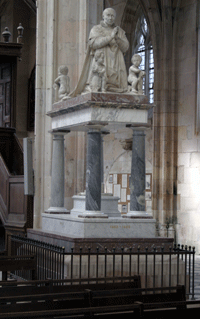 |
 |
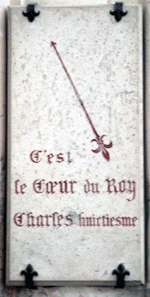 |
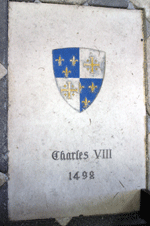 |
| King Louis XI
'The Universal Spider' (1483) Louis was
one of the very few kings of France who wished
to be buried elsewhere than St Denis.
A drawing from 1481 is still extant of the projected effigy and which shows the King kneeling but wearing armour and with shoulder length hair; this was perhaps based on an earlier design of 1472 by Jean Fouchet. This drawing probably differs from the final monuments constructed by Conrad of Cologne, goldsmith of Tours and Laurent Wrine, cannon maker, in gilt bronze and enamelled brass. This was melted down by the Hugenots in 1562. The present effigy, sculptured in 1622 is the work of Michel Bourdin of Orleans, painter and architect of Paris, who constructed the monuments according to a design drawn by him in 1617. This was destroyed in 1792 but the remains were collected by Alexandre Lenoir (who has been referred to in the section on St Denis) for display in his museum and reconstructed by the sculptor Besuvallet and the marbler Scellier. In 1818 the Prefect of the Loiret transferred the monument back to Cléry and a base was constructed by the architect Pagot and the sculptor Romagnesi. A drawing by an English visitor of this base - more in keeping than the present one - still exists. During the restoration of the church in 1868 the tomb was again dismantled and in 1874 the effigy repositioned on a simple slab at ground level. It was replaced in 1896 on the present incongruous base which was constructed by the sculptor Libersac and the marbler Barberon. The King and his Queen, Charlotte of Savoy, are buried in a vault which can be entered via a floor grill at the side of the monument; there their skulls may be seen displayed. Watch this space! |
Above: The
heart of Louis's son Charles VIII (1498)
was also buried at Cléry; above left is a stone
mounted on the wall, which reproduces the
inscription on the casket which contains the
heart and, right, the stone above the actual
burial vault. His monument at St Denis was
destroyed at the Revolution. Below Left: stone with simple cross and inscription, now mounted on wall. Right: Stone on floor marking the burial of the Breton Tanneguy du Chastel (1477 ) He was killed by cannon fire while leaning on the King's shoulder at the seige of Bouchain; he was buried here on Louis's request. |
||
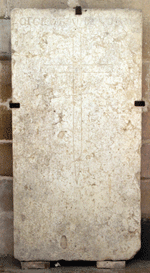 |
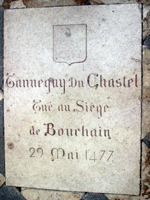 |
||
 |
Ferrières-en-Gâtinais Abbaye Saint-Pierre-et-Saint-Paul |
 |
| Church open during normal hours. Park in
the small free car park outside the entrance to the church,
although there is plenty of parking elsewhere. Impossible to
find anywhere to eat Saturday lunch time in this large village. Ref: 48° 05' N / 2° 18' E |
 |
 |
Tomb of Abbé Louis de Blanchefort (1505), who restored the church and revived the community following devastation by the English in the 100 Years' Way. The tomb is said to have had an effigy by, possibly, Jean Juste but this was destroyed in the 16th century; there is now no evidence of its existence. |
|
| Montargis -
Musée Girodet |
| There is time limited paid parking in the
street just outside the museum. The museum is closed at weekend
so it is best to chech opening times before visiting: we didn't! |
| In the museum is reported to be a terra cotta study for the monument to Albert of Saxe-Cobourg-Gotha, prince consort of Queen Victoria, in the Albert Memorial Chapel of St George's Chapel, Winsor, Berkshire. This was by the scuptor Henri de Triqueti 1871 but refused by Queen Victoria. |
|
|||||
 |
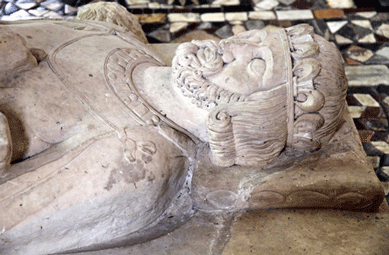 |
||||
King Phillipe I ( 1108 ) He was king of France from the age of eight and during his reign there occured both the Norman Conquest of England and the First Crusade. He was buried here before the high altar - one of the very few Franch kings not to have been buried at St Denis - but the effigy has moved positions over the years. The King did not take part in the First Crusade - although his brother did so - being under the sentence of excommunication for contracting a bigamous marriage with Bertrande, the wife of the Duke of Anjou. He was known as Phillipe the Amorous. |
|||||

